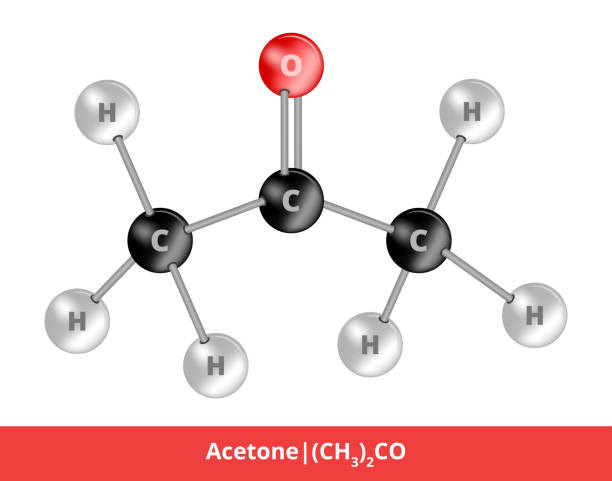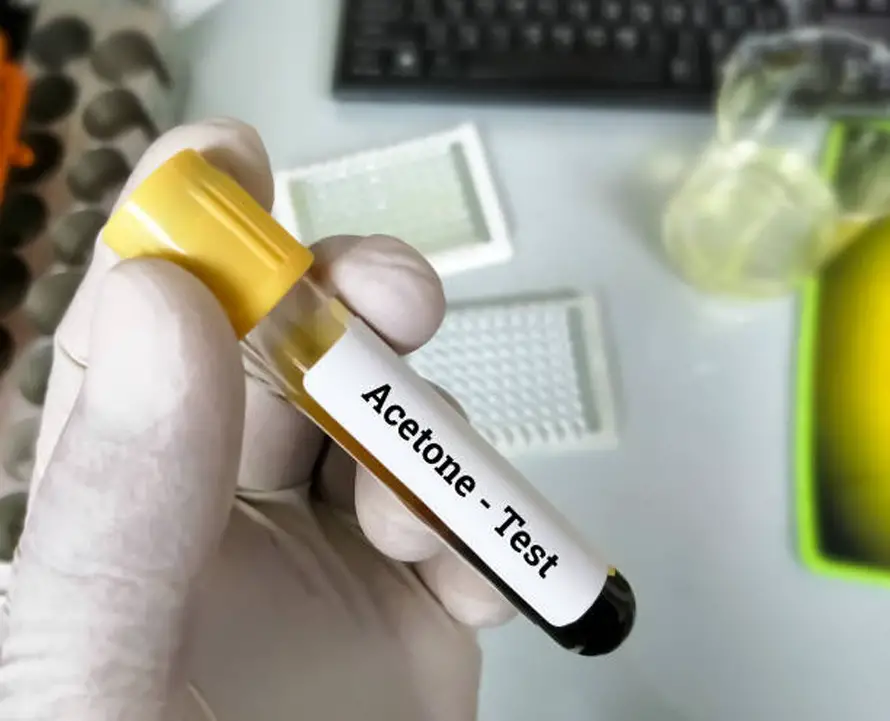Acetone is a handy chemical if you need to remove nail polish. It is also useful when trying to get rid of grease stains. Sadly, spillages can still occur every now and then. The question now is, will acetone stain clothes?

What is acetone made of
While acetone is a term that will make you think of a chemical substance, the truth is that it is a type of organic compound.

Acetone or also called propanone contains oxygen, hydrogen, and carbon and forms a highly flammable colorless liquid.
The unique organic structure of acetone has the ability to break down fats, oils, plastic, and rubber. You can find it in homes commonly in nail polish remover form as well as paint thinner and in certain facial and cosmetic treatments. The human body also produces acetone as metabolism’s natural by-product.
When used properly and in the correct amount, acetone is considered as non-toxic. But, there are chemically created acetone blends with a strength enough for cleaning up oil spills. These can also be added into gasoline to boost fuel efficiency.
Is acetone and mineral spirits the same

Acetone and mineral spirits both come in handy because these two common solvents work great for different uses and purposes. From preparing the surface to thinning up to clean up, they have important roles to play in the painting process. Acetone and mineral spirits alike can help clean up different messes that soap and water alone cannot handle.
However, these two solvents have some notable differences. Mineral spirits and acetone must never be used interchangeably. You might prefer one over the other depending on the job and there are also contexts when one may cause serious problems.
Mineral spirits and acetone are not the same and you should not treat them as if they are.
The confusion is due to the fact that that these two are being used as thinners. For instance, painters often use mineral spirits for thinning the paint they put in paint sprayers. On the other hand, acetone is used for thinning lacquer. Once someone gets used to one thinner, they sometimes use the other for a similar application only to be disappointed that they don’t get similar results.
Mineral spirits and acetone are also both handy for cleaning different messes around the house, in the shop, and on tools. But even here, these two are not identical. For instance, both are great for removing paint spills.
However, while acetone aggressively strips paint from various surfaces, mineral spirits only works on removing fresh paint. This can clean brushes as well as other tools after finishing a project but after the paint dries up, it will no longer be effective to use mineral spirits.
Mineral spirits is also not soluble in water and has lesser fire hazard compared to acetone.
Can acetone stain clothes
Acetone stains clothes and fabrics, especially if acetone and other chemicals are blended together. Aside from that, acetone may even prove to be disastrous for fabrics that contain triacetate, acetate, or modacrylic fibers that are basically plastics. Since acetone is a form of solvent that eats plastic, this can dissolve the said fabrics in a snap of a finger.
Instead of causing stains, natural fibers such as wool and silk can get damaged by acetone. You have to be sure what your clothes are made from before you try to remove acetone stains or remove stains with it.
Although nothing much can be done to repair damaged or dissolved fabrics, you can use a stain remover in the wash to get rid of acetone stains. However, take note that acetone tends to remove fabric color.
Being a solvent that removes nail polish, acetone cannot differentiate between the colors that must be kept and those that should be removed. The removal of the color of the fabric may sometimes appear like stains. Ensure that your clothes are colorfast before you try to use acetone to remove nail polish from them.
Will acetone ruin your clothes
Sadly, acetone can damage and ruin clothes. Again, make sure that the acetone is not mixed with other chemicals since this might lead to stains. As stated earlier, never use acetone on triacetate, modacrylic, and acetate fabrics.
How to reverse acetone damage
Apply some dishwashing solution using white washcloth to acetone residues and work this in gently from the spill’s edges to the center for several minutes. Avoid rubbing it in. Continue until the spill is completely removed.
Does acetone come out of clothes
Acetone has the tendency to evaporate fast. This means that it is not likely for pure acetone to leave behind any unwanted traces. Problems only occur if you are dealing with acetone blends.
How to remove acetone stain from clothes
If you used acetone on your clothes to get rid of grease stains but it left behind some ugly marks, this is probably acetone residue. As stated earlier, mixing acetone with other chemicals will cause residual staining.
You need to act fast to remove residue stains. Treatment must begin before acetone evaporates.
- Use an absorbent cloth or old towel for blotting the spilled acetone. Gently scrape up any solids that formed using the spoon’s round end or other blunt tools.
- Grab the dishwashing liquid. Mix it with lukewarm water and apply this on your clothes using a rag. You need one cup of water and ¼ teaspoon of dishwashing liquid. Work from the outer part of the stain to the center with the use of a dabbing motion. Avoid rubbing or using pressure since a heavy hand only damages the garment further. Continue doing so until you remove the stain.
- Use a clean rag for blotting and soaking up the mixture of dish liquid and acetone stain. Continue until all the solution is soaked up in the rag. You might use several rags for the mixture to soak up.
- Rinse using cold water to ensure that you remove all residues. Blot it gently with dry towel to get rid of any remaining moisture and wash your clothes the usual way.
Other acetone stain removal guides
How to fix Acetone on leather couch
If you have used Acetone based cleaner to remove stains on your leather couch and it leaves some stains behind, check the details below for information on how to remove such stains.
- Pour a moderate amount of neatsfoot oil on microfiber cloths.
- Rub the microfiber cloth on the entire stained spot as swift and quickly as possible.
- Suck up all excessive oil on the leather surface with an absorbent towel or cloth afterward.
- Leave to air dry.
If you would like to make a strong cleaner out of your neatsfoot oil, mix 2 parts of neatsfoot oil with 1 part of vinegar and apply just as explained earlier.
How to remove acetone stain from table
Follow the steps below for information on how to remove acetone from a hardwood table.
- Make a solution from the mixtures of 2 cups of water and a tablespoon of liquid dishwashing soap.
- Dip a clean white cloth in the solution and sponge the surface with it.
- Blot excess liquid from the surface until there’s none left.
- If the stain persists, repeat the process. If the stain is gone, wipe the treated spot with a clean cloth soaked in cold water to rinse the surface and blot dry.
How to remove Acetone stains from sink
Check below for information on how best you can remove Acetone stains from the sink.
- Make a solution from the mixtures of parts of water to 1 part of vinegar and a few drops of liquid dishwashing soap.
- Dip a microfiber cloth or towel in the solution and use it to scrub the stained spot until the Acetone stain is completely lifted.
- Wipe a clean cloth or towel on the treated surface to dry it up.
How to reverse Acetone damage on plastic
Plastic is made of polymer, a substance that can be easily dissolved by Acetone. If you notice any damage on your plastic after spilling Acetone or cleaning the plastic with an Acetone based cleaner, check below for information on how best it can be removed.
- Apply liquid dishwashing soap on a clean white washcloth.
- Blot gently on the damage without rubbing for a few minutes starting stain edges and down to the center.
- Repeat this as many times as required until the plastic becomes spotless.
How to reverse Acetone damage on woods
Acetone lifts off all lacquer coating on wording furniture or flooring and if care is not taken, it can eat through the entire wooden surface. If you spill Acetone on your wooden surface and you would like to restore its fine finish, check below for details on how to go about it.
- Spray a light coat of aerosol lacquer on the damaged spot.
- Wait for a few minutes for it to dry, sand with steel wool, and spray over the treated spot again.
- Repeat the process as many times as possible until the fine finish is restored.
How to remove Acetone stain from vinyl flooring
Vinyl flooring is resistant to stains except when it comes with contact with any rubber material. Vinyl flooring is also susceptible to Acetone can cause some damage to the floor if appropriate steps are not taken. Check below for details on how you can remove acetone stains from Vinyl flooring.
- Pour rubbing alcohol on a clean cloth or towel, make sure it is saturated.
- Rub the stained spot with and leave it to sit for some minutes.
- Once the stain is completely gone, rinse off the surface.
How to remove Acetone stains on leather
Check below for information on how to get rid of Acetone stains from leather surfaces.
- Saturate a cotton swab with rubbing alcohol.
- Dab gently on the stained soot until the stain is completely gone.
Frequently Asked Questions
Will Acetone stain jeans?
No, Acetone will not stain your jeans. Acetone in its purest form is colorless and less likely to cause stains on fabrics or garments. However, it could bleach the jeans.
Also, when mixed with other chemicals like conditioners or some other chemicals with staining effect as it is in the case of nail polish remover, it could stain your jean or any other surfaces it comes in contact with.
Can Acetone stain carpet?
No, Acetone will not stain your carpet. Just as it is in the case of clothes, pure Acetone will not stain your carpet: however, depending on the material that your carpet is made of, it could bleach it; and in some cases, may even damage the carpet. Therefore, before using Acetone either in its purest form or not, it is best to test on an unobtrusive part of the material.
Will Acetone stain leather?
No, Acetone will not stain your leather surface, however, it can have a damaging effect if used wrongly. The part of your leather surface whether it be clothes, furniture, or shoes that are most likely to be affected by Acetone is the fiber structure, the tanning components as well as the upper layer of the leather. When this occurs, you will notice obvious cracks and holes, and the surface will start to brittle.
Will Acetone stain glass?
No, Acetone when used as a glass cleaner will not leave any stain if used appropriately. However, you have to be careful though because Acetone might damage your glass.
Curious to know can we use dettol to wash clothes, does aquaphor wash out of clothes or why have black spots on clothes in rainy season too?
References
- https://pubchem.ncbi.nlm.nih.gov/compound/Acetone
- https://www.ccohs.ca/oshanswers/chemicals/chem_profiles/acetone.html

“Your home is a representation of yourself, and it should only be filled with clean items that you enjoy and use”
Professional cleaning expert

![Will rubbing alcohol ruin furniture [Truth Exposed]](https://sanitisationsingapore.com/wp-content/uploads/2021/09/Will-rubbing-alcohol-ruin-furniture-426x208.webp)

